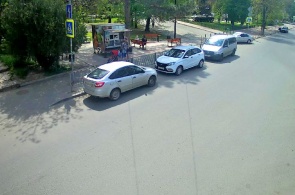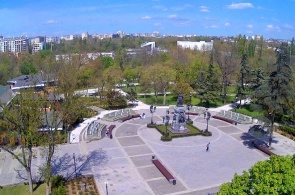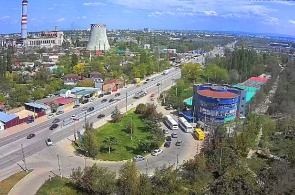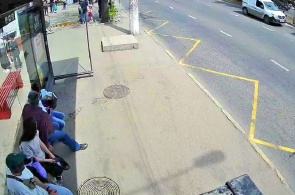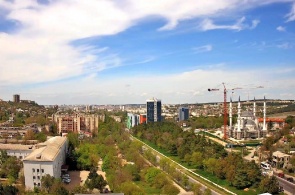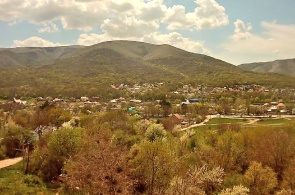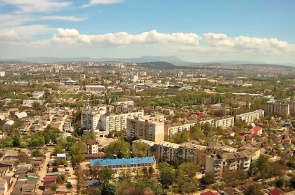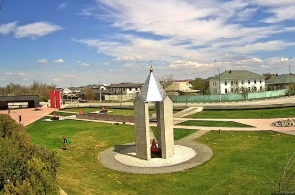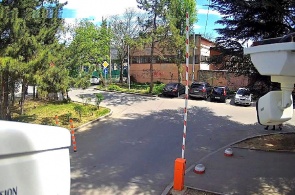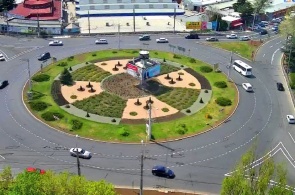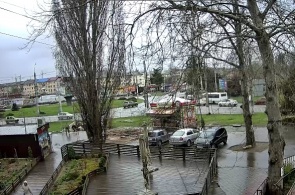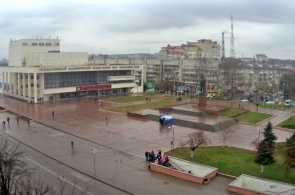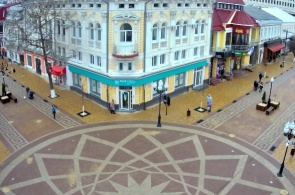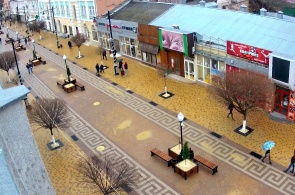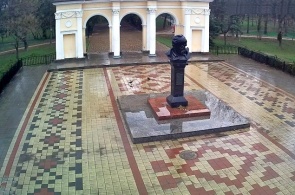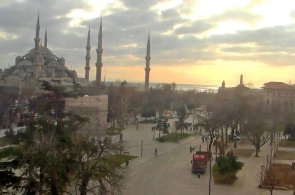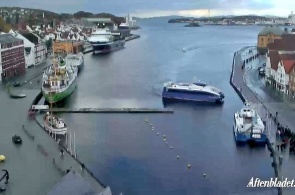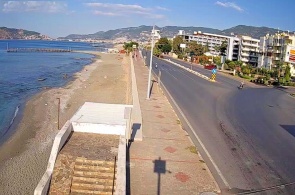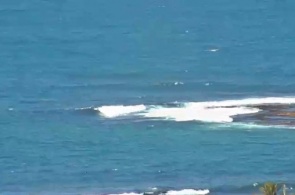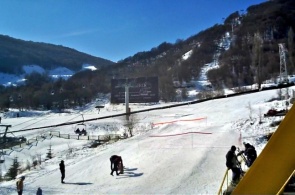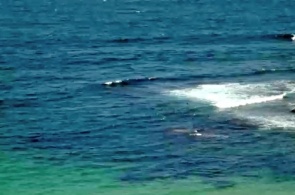Live webcam broadcasts in real time Rostovskaya Street in Simferopol. Simferopol is the capital of Crimea. The name is translated from Greek as "city of the common good" or "guardian city". It is located not on the sea coast, but in the depths of the peninsula. However, this does not take away its charm.
Simferopol is called “the gates of Crimea” because the way to the mountains and sea resorts lies through the capital's railway station and airport. Do not hurry. Stay in the city for at least a couple of days. It is worth your attention.
On the map, Simferopol looks like the center of a star with seven rays - that is how many roads lead to the city from all sides of the peninsula. It fills the valley formed by the Salgir River, as well as two ranges of the Crimean mountains - the Outer and the Inner. The higher Inner Ridge closes the city from the sea, creating a special microclimate. It is only 40 kilometers in a straight line to the Black Sea coast, but in the city it is not felt at all. It seems that you are in the endless steppe.
The Salgir River flows through the city. With a length of 232 kilometers, it is considered not only the longest, but also the longest river on the Crimean peninsula. Nevertheless, almost every year in summer, the current dries up below Simferopol. This indicates a lack of precipitation. Within the city limits, the tributaries Maly Salgir, Abdalka, Kazanka and Slavyanka flow into the river.
The Simferopol reservoir is located on the southeastern outskirts. The largest Crimean man-made reservoir was built in 1954. The idea of construction appeared back in 1910. Then a cholera epidemic broke out in Simferopol, and at the same time there was a colossal shortage of drinking water. Surveys were carried out, but the project was frozen by the First World War. Only in the middle of the century was Salgir blocked with a dam. Now the reservoir is used for urban water supply and land irrigation.
Despite the proximity to the sea, the local climate belongs to the foothill dry steppe type. The long winter lasts from mid-February to mid-May. Summer heat ends at the end of September. Warm autumn ends on New Year's Eve. Winter is short and mild. On average, it lasts about a month. In January, there are frosts down to -3 degrees, but usually the thermometer does not drop below zero. The average summer temperature is +24 degrees. But a forty-degree heat may also happen. There is very little rainfall during the year.
Simferopol is called “the gates of Crimea” because the way to the mountains and sea resorts lies through the capital's railway station and airport. Do not hurry. Stay in the city for at least a couple of days. It is worth your attention.
On the map, Simferopol looks like the center of a star with seven rays - that is how many roads lead to the city from all sides of the peninsula. It fills the valley formed by the Salgir River, as well as two ranges of the Crimean mountains - the Outer and the Inner. The higher Inner Ridge closes the city from the sea, creating a special microclimate. It is only 40 kilometers in a straight line to the Black Sea coast, but in the city it is not felt at all. It seems that you are in the endless steppe.
The Salgir River flows through the city. With a length of 232 kilometers, it is considered not only the longest, but also the longest river on the Crimean peninsula. Nevertheless, almost every year in summer, the current dries up below Simferopol. This indicates a lack of precipitation. Within the city limits, the tributaries Maly Salgir, Abdalka, Kazanka and Slavyanka flow into the river.
The Simferopol reservoir is located on the southeastern outskirts. The largest Crimean man-made reservoir was built in 1954. The idea of construction appeared back in 1910. Then a cholera epidemic broke out in Simferopol, and at the same time there was a colossal shortage of drinking water. Surveys were carried out, but the project was frozen by the First World War. Only in the middle of the century was Salgir blocked with a dam. Now the reservoir is used for urban water supply and land irrigation.
Despite the proximity to the sea, the local climate belongs to the foothill dry steppe type. The long winter lasts from mid-February to mid-May. Summer heat ends at the end of September. Warm autumn ends on New Year's Eve. Winter is short and mild. On average, it lasts about a month. In January, there are frosts down to -3 degrees, but usually the thermometer does not drop below zero. The average summer temperature is +24 degrees. But a forty-degree heat may also happen. There is very little rainfall during the year.
More details
Live webcam broadcasts in real time Mendeleev Street, in the capital of Crimea - Simferopol. In March 1904, this then new street, which arose on the so-called Sultan Meadow, was named Mendeleevskaya. The Duma and the government could not ignore the giant of scientific thought, the creator of the periodic table of elements. Moreover, the great chemist began his career in Simferopol.
Simferopol, Crimea
03.07.21
Live webcam in the Catherine Park of Simferopol, in the foreshortening of this webcam, we can observe the monument to Catherine II. The Catherine Garden is the oldest public park in Simferopol. The first trees were planted on the banks of the Salgir back in 1820, and immediately the magnificent English-style park became a favorite walking place for the townspeople.
Simferopol, Crimea
03.07.21
Live webcam broadcasts in real time a panoramic view of the village of Gresovsky located 8 km from Simferopol on the banks of the Salgir River. Founded on the site of the former village of Zamosc. Among Simferopol residents it is known as the state district power station.
Simferopol, Crimea
27.06.21
Live webcam broadcasts in real time the stop "Cinema Zvezda" in Simferopol. On the site of modern Simferopol, the first people settled in the Paleolithic era, about 50 thousand years ago. On the left bank of the Salgir, in the Chokurcha cave, archaeologists discovered the site of the most ancient people.
Simferopol, Crimea
27.06.21
Live webcam broadcasts in real time the largest mosque in Crimea - the Cathedral Mosque in Simferopol. Today Kebir-Jami is the main Friday cathedral mosque in Simferopol, the residence of the mufti and the Spiritual Administration of Muslims of Crimea. The complex includes a madrasah (educational institution) and a library.
Simferopol, Crimea
27.06.21
The web camera online broadcasts in real time the village of Perevalny, a view of the mountains. The village of Perevalny is located on the Simferopol-Yalta highway, 24 km from Simferopol at the northern foot of the Chatyr-Dag massif. The first name of the village of Angara, in 1945 renamed the Pereval. The first mention dates back to 1864 as a tavern on the river Angara, under the same name.
Simferopol, Crimea
12.06.21
The web camera online broadcasts in real time one of the favorite observation decks of Simferopol residents on the street of Marshal Shchukov. Simferopol is the second largest city in Crimea. It stands on the Salgir River away from the Black Sea coast, so it is impossible to call Simferopol a resort in its purest form. However, there are enough attractions to fill the schedule of any tourist under the knot.
Simferopol, Crimea
12.06.21
Live webcam broadcasts in real time a memorial to the victims of the Nazi occupation of Crimea in 1941-1944 "Red concentration camp". "Krasny" is a state farm near Simferopol, on the territory of which the German-fascist occupation authorities, with the complicity of collaborationists from the local population, organized the largest death camp in Crimea in September 1941.
Simferopol, Crimea
09.05.21
Live webcam overlooking Liza Chaikina Street in Simferopol. Elizaveta Ivanovna Chaikina - secretary of the Penovsky underground district committee of the Komsomol of the Kalinin region, one of the organizers of the partisan detachment during the Great Patriotic War. Hero of the Soviet Union. Liza was shot by the Nazis on November 23, 1941. Streets in many cities of Russia and the CIS countries are named after her.
Simferopol, Crimea
08.05.21
Live webcam in Simferopol, overlooking Moscow Square. Along the ring of Moskovskaya square you can go to Kievskaya and Kechkemetskaya streets. Initially, the street was called Perekopskaya, after an active period of development in the 60s of the last century, it was renamed in honor of the great Soviet cosmonaut into Gagarin Street.
Simferopol, Crimea
08.05.21
Web camera in Simferopol, Kirov Avenue with views of the main square of city - Lenin square.
Simferopol, Crimea
02.04.17
Webcam at the intersection of Central streets of Simferopol - Karl Marx and Pushkin.
Simferopol, Crimea
02.04.17
The web camera installed on the pedestrian area of Catherine street (former Karla Marksa) in Simferopol.
Simferopol, Crimea
26.03.17
popular camerasshow all
Sultanahmet or Blue mosque is a work of art of Turkish-Islamic architecture. Its construction began in 1609, the construction work took seven years to a 19-year-old Sultan. The name of the mosque was, due to its interesting and unique finish.
Istanbul, Turkey
Stavanger, a town in the commune of Norway, located in the South-Western part of the country, on the Peninsula, rich in minerals. Tanager combines the influence of foreign organisations such as NATO and oil companies. The camera will shoot the harbour and the promenade of the city.
Stavanger, Norway
A webcam broadcasts the district of Tosmur - quiet location in the Eastern part of Alanya, located only five kilometres from the city centre. Its rural way of life and the beauty of untouched nature attract tourists.
Alanya, Turkey
Shark Island or in English of Shark island, located in the harbour city of Sydney, the suburb of Point Piper. The locals, the natives named the island Boambilly, which translated means Shark island. After all, this name is not casual, because it's mean and looks like a shark fin.
Sydney, Australia
The webcam is installed on site Alva. Tsaghkadzor ski resort town in Armenia. Tsaghkadzor is a beautiful mountainous area among deciduous forests, with a pleasant winter climate, and clean fresh air. The highest point is 1800 meters. The truss type is a classic, divided into three.
Tsakhkadzor, Armenia

